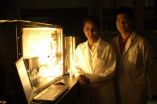(Press-News.org) (Toronto, Canada – January 20, 2011) – Cancer scientists led by Dr. John Dick at the Ontario Cancer Institute (OCI) and collaborators at St Jude Children's Research Hospital (Memphis) have found that defective genes and the individual leukemia cells that carry them are organized in a more complex way than previously thought.
The findings, published today in Nature (DOI:10.1038/nature09733), challenge the conventional scientific view that cancer progresses as a linear series of genetic events and that all the cells in a tumour share the same genetic abnormalities and the same growth properties.
"Our results show this is not the case and open the way to discover how genetic abnormalities transform normal cells into leukemic cells and the steps that have to happen to make the leukemic cells increasingly abnormal and aggressive, how leukemic cells at different steps of genetic evolution (or progression) respond to therapy, or contribute to relapse," says Dr. Dick, Senior Scientist at OCI's Campbell Family Institute for Cancer Research, the research arm of Princess Margaret Hospital, and the McEwen Centre for Regenerative Medicine at University Health Network. Dr. Dick is also a Professor in the Department of Molecular Genetics, University of Toronto, and Director of the Cancer Stem Cell Program at the Ontario Institute for Cancer Research.
The research team found that the leukemia cells taken from patients with acute lymphoblastic leukemia (ALL) are actually composed of multiple families of genetically distinct leukemia cells. They looked at how these families developed and retraced the ALL "family tree" back to its origins. They discovered that the so-called black sheep – the cells that propagate the disease and potentially survive therapy – persist through generations, and even branch off and evolve to form genetically distinct cancer families. Some of these genetic families dominate, making it appear that the leukemia cells only have one set of genetic abnormalities while other families are very rare, explaining why they had never been seen before.
The study results provide data linking genetic events in ALL taken from patients when first diagnosed to their future clinical survival. In the lab, the researchers reproduced human ALL in mice transplanted with patient leukemia samples. Sometimes the dominant genetic family would grow in the mice while in other mice the rarer families would grow.
"By looking at the genetic signatures of the leukemia cells in the different mice we were able to figure out their genetic ancestry and the evolutionary trajectory that that particular leukemia took. We found that if a particular gene family was mutated, the tumours were aggressive when grown in the mice. The patients with the corresponding tumours had poorer survival showing that the human-mouse transplant system could be very useful in predicting patient outcome."
This insight into genetic diversity has positive implications for cancer treatment, says Dr. Dick. "Understanding the complexity of cellular relationships and the existence of distinct genetic families of leukemia cells will shed light on why some cells of the cancer are not killed by the therapy and eventually regrow resulting in disease relapse, and help accelerate the development of tailored therapies to wipe out all the unwanted branches in the genetic tree."
Research collaborator Dr. Charles Mullighan, a hematologist at St. Jude Children's Research Hospital, adds: "Overall, the study proved that many leukemias comprise multiple subpopulations with different genetic alterations, and that these genetic alterations may evolve over time. The main clinical implication is that we now need to extend this work to identify genetic changes at low levels at diagnosis that confer a high risk of treatment failure and relapse and find ways of targeting them."
The current research builds from earlier findings published in 2007 when the Dick team developed a method to convert normal human blood cells into "human" leukemia stem cells. The converted cells, when transplanted into special mice that permit the growth of human cells, can replicate the entire disease process from the very moment it begins.
In 1994, Dr. Dick identified the first cancer stem cell in leukemia, following on the original discovery in 1961 of the blood stem cell by renowned OCI scientists, Drs. Ernest McCulloch and James Till -- a discovery that formed the basis of all current stem cell research. Dr. Dick, who holds the Canada Research Chair in Stem Cell Biology, has published other findings showing that colon cancer arises from stem cells specific to the tumour.
INFORMATION:
The research published today was financially supported by grants and fellowships from the Canadian Institutes for Health Research, the Pew Charitable Trusts, The Stem Cell Network of Canadian National Centres of Excellence, the Canadian Cancer Society, Genome Canada through the Ontario Genomics Institute, Ontario Institute for Cancer Research, the Leukemia and Lymphoma Society, a Canada Research Chair, the American and Lebanese Syrian Associated Charities of St. Jude Children's Research Hospital, and the Ontario Ministry of Health and Long Term Care.
Princess Margaret Hospital and its research arm Ontario Cancer Institute, which includes The Campbell Family Cancer Research Institute, have achieved an international reputation as global leaders in the fight against cancer. Princess Margaret Hospital is a member of the University Health Network, which also includes Toronto General Hospital and Toronto Western Hospital. All three are research hospitals affiliated with the University of Toronto. For more information, go to www.uhn.ca
For more information:
Princess Margaret Hospital: Jane Finlayson, Public Affairs, (416) 946-2846 jane.finlayson@uhn.on.ca
END
Society has long debated the contrasting advantages of monogamy and promiscuity and, in western society at least, the long term benefits of monogamy have in general won out. However new research published in BioMed Central's open access journal BMC Evolutionary Biology shows that sperm from polygamous mice are better competitors in the race for fertilisation.
Dr Renée Firman at the Centre for Evolutionary Biology, University of Western Australia, has used house mice to show that sperm from rival males compete to fertilise females and that, over several generations, polygamy ...
What makes music beautiful? The best compositions transcend culture and time – but what is the commonality which underscores their appeal? New research published in BioMed Central's open access journal BMC Research Notes suggests that the brain simplifies complex patterns, much in the same way that 'lossless' music compression formats reduce audio files, by removing redundant data and identifying patterns.
There is a long held theory that the subconscious mind can recognise patterns within complex data and that we are hardwired to find simple patterns pleasurable. Dr ...
A multifaceted quality improvement intervention that included education, reminders and feedback through a collaborative telecommunication network improved the adoption of evidenced-based care practices in intensive care units at community hospitals for practices such as preventing catheter-related bloodstream infections and ventilator-associated pneumonia, according to a study that will appear in the January 26 issue of JAMA. The study is being published early online to coincide with its presentation at the annual meeting of the Society of Critical Care Medicine.
Despite ...
CHAMPAIGN, Ill. — University of Illinois materials scientists have developed a simple, generalizable technique to fabricate complex structures that assemble themselves.
Their advance, published in the Jan. 20 issue of Nature, utilizes a new class of self-assembling materials that they developed. The team demonstrated that they can produce a large, complex structure – an intricate lattice – from tiny colloidal particles called triblock Janus spheres.
"This is a big step forward in showing how to make non-trivial, non-obvious structures from a very simple thing," said ...
Cambridge, Mass., January 19, 2011 – Invention and innovation are essential to remaining globally competitive, and a new survey shows an untapped group of potential inventors in the U.S. The 2011 Lemelson-MIT Invention Index , announced today, indicates that American women ages 16 – 25 possess many characteristics necessary to become inventors, such as creativity, interest in science and math, desire to develop altruistic inventions, and preference for working in groups or with mentors – yet they still do not see themselves as inventive. Young men in the same age group ...
TORONTO, ON –Adult children of divorce are more likely to have seriously considered suicide than their peers from intact families, suggests new research from the University of Toronto
In a paper published online this week in the journal Psychiatry Research, investigators examined gender specific differences among a sample of 6,647 adults, of whom 695 had experienced parental divorce before the age of 18. The study found that men from divorced families had more than three times the odds of suicidal ideation in comparison to men whose parents had not divorced. Adult daughters ...
Case Western Reserve University School of Medicine and Athersys, Inc. (NASDAQ: ATHX) announced a joint scientific study on spinal cord injury will be published today in the January issue of the Journal of Neuroscience. The study, by leading researchers from the Department of Neurosciences at the School of Medicine and scientists at Athersys, presents data supporting the potential therapeutic benefit of Athersys' MultiStem® program for spinal cord injury. Researchers observed that administration of Multipotent Adult Progenitor Cells (MAPC) following spinal cord injury in ...
PASADENA, Calif.—Using a common metal most famously found in self-cleaning ovens, Sossina Haile hopes to change our energy future. The metal is cerium oxide—or ceria—and it is the centerpiece of a promising new technology developed by Haile and her colleagues that concentrates solar energy and uses it to efficiently convert carbon dioxide and water into fuels.
Solar energy has long been touted as the solution to our energy woes, but while it is plentiful and free, it can't be bottled up and transported from sunny locations to the drearier—but more energy-hungry—parts ...
Australian scientists using new image and cell technologies have for the first time caught malaria parasites in the act of invading red blood cells. The researchers, from the Walter and Eliza Hall Institute in Melbourne, Australia, and the University of Technology, Sydney (UTS), achieved this long-held aim using a combination of electron, light and super resolution microscopy, a technology platform new to Australia.
The detailed look at what occurs as the parasite burrows through the walls of red blood cells provides new insights into the molecular and cellular events ...
A University of British Columbia study shows that there are enough pharmacies situated throughout Ontario communities to absorb many closures without negatively affecting geographical accessibility for residents. The research suggests concerns that reducing generic pricing could result in pharmacy shortages are unfounded.
Last summer, the Ontario government cut the price of generic drugs by half – to approximately 25 per cent of the equivalent brand – leading to heated discussions on the sustainability of existing pharmacies. Some pharmacy chains claimed they might be ...



